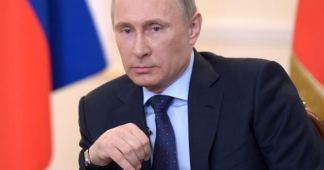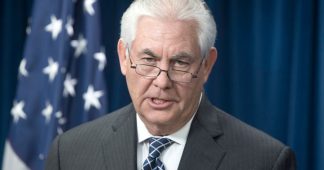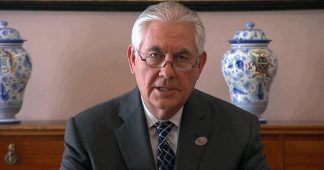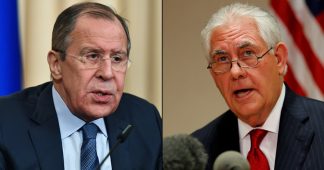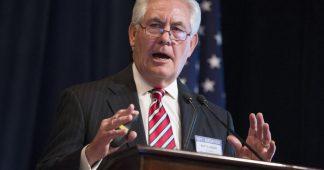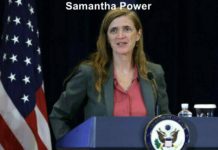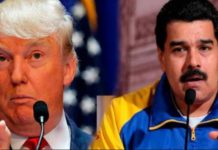Spencer Ackerman in New York
Confused by Donald Trump’s policy on Syria? That just means you’ve been listening to what his administration has been saying in the last few days.
The US secretary of state, Rex Tillerson, is to fly to Moscow on Tuesday, where the novice US diplomat is expected to discuss the fate of Bashar al-Assad. Meanwhile, the world is still trying to understand just what goal Trump’s fledgling administration is pursuing in Syria.
For years, Trump advocated against intervention in Syria’s war, except to attack the Islamic State militant group in a related but separate conflict. That policy seemed to end on Thursday, after the chemical weapons attack on Khan Sheikhoun on 4 April. Yet almost as soon as Trump ordered retaliatory strikes on a Syrian airbase from which the US said the regime had launched the chemical attack, his aides suggested that the one-off strike had satisfied US objectives.
Until they contradicted themselves again.
It may not be clear what the US policy toward Syria actually is, including to senior policymakers whose divergent and even contradictory statements have overlapped with one another. But here, at least, is what they have said.
Policy 1 – Assad can stay: 2013 – 30 March 2017
For years, as a private citizen on Twitter and as a presidential candidate, Trump was fine with Assad remaining in power, contending that the US should not get sucked into another Middle Eastern conflict, particularly one against a leader backed by Russia. After winning the election, Trump told the Wall Street Journal: “My attitude was you’re fighting Syria, Syria is fighting Isis, and you have to get rid of Isis.” Assad quickly called Trump a “natural ally”.
On 30 March, Trump’s senior diplomats articulated that position clearly. Nikki Haley, the US ambassador to the United Nations, mused that the US needed to “pick and choose [its] battles”, despite Assad’s human rights abuses: “Our priority is no longer to sit and focus on getting Assad out.”
That same day, in Turkey, Tillerson said Assad’s “longer-term status … will be decided by the Syrian people”.
Since the Syrian people live in one of the world’s bloodiest war zones, besieged by Assad’s forces and others, observers understood Tillerson and Haley to say that the US was abandoning Barack Obama’s rhetorical commitment to Assad’s removal. Senator John McCain, a hawk on Syria, called himself “deeply disturbed” by Tillerson and Haley’s position.
“Ultimately, the administration’s statements today could lead America’s true allies and partners in the fight against Isis to fear the worst: a Faustian bargain with Assad and Putin sealed with an empty promise of counter-terrorism cooperation,” McCain said.
Five days later, Assad killed at least 70 people in Khan Sheikhoun, including children, with the nerve agent sarin.
Policy 2 – Assad must go, after chemical attack: 5-6 April 2017
By Wednesday, the first day dominated by images of the dead at Khan Sheikhoun, Trump expressed public anger, saying Assad had crossed “many, many lines”. By then, military planning for a retaliatory strike was under way.
But what was the objective of the strike? Hours before guided-missile destroyers launched 59 Tomahawk missiles on Thursday, Tillerson indicated that Trump had reversed himself completely. Tillerson certainly had.
“Assad’s role in the future is uncertain, clearly. With the acts that he has taken, it would seem that there would be no role for him to govern the Syrian people,” he said. Asked if the US was prepared to diplomatically rally an international coalition to remove Assad from power through what Tillerson called “a political process”, Tillerson responded: “Those steps are under way.”
The missiles that soon landed on the Shayrat airbase seemed, accordingly, to mark the first salvo toward the US ousting Assad.
Policy 3 – The issue is chemical weapons use, not Assad: 6-10 April 2017
Hours after the missile strike, the newly empowered national security adviser HR McMaster, whose career was made by a different Middle Eastern war, defined the US attack in minimalist terms: “It was aimed at the capacity to commit mass murder with chemical weapons, but it was not of a scope or a scale that it would go after all such related facilities.” Next to McMaster, Tillerson said the chemical attack was “particular[ly] heinous”, over and above Assad’s brutality with conventional weapons.
Notably absent from McMaster’s explanation of the strikes was any indication of whether Assad’s removal was a US objective at all. (The strike itself would not have affected Assad’s hold on power, but if endangering that hold were once again a US goal, it would have to be the first of many.) Instead, McMaster said, the strike ought to prompt “a big shift in Assad’s calculus” against chemical weapons use. Assad’s calculus, however, should not matter to the US if he is no longer in power.
On 10 April, the US defense secretary, James Mattis, issued a statement similar to that of his ally McMaster: “The Syrian government would be ill-advised ever again to use chemical weapons.” But that was after several statements with different policy implications.
Policy 4 – Attack Isis first, then Assad can stay or go depending on whether Russia agrees: 9 April 2017
Tillerson, making his first appearance on the Sunday chatshows, sounded more like his 30 March self than his 6 April incarnation. “Our priority is first the defeat of Isis,” he said – which, in fairness, he had also said on 6 April in what seemed like a throwaway line. Once the US could “conclude” that war, the US would attempt to broker ceasefire agreements between the Syrian civil war’s various combatants – even though Assad, with Russian support, has violated ceasefires in the past.
Tillerson said he was “hopeful” to work with Russia “and use their influence to achieve areas of stabilization throughout Syria and create the conditions for a political process through Geneva in which we can engage all of the parties on a way forward”.
Through that process – apparently not yet “under way”, despite Tillerson’s 6 April statement – the international community would “decide the fate of Bashar Assad”.
Nothing about Tillerson’s statement implied that Assad’s “fate” would be to leave power. The “areas of stabilization” in Syria that Russia has facilitated have propped Assad up, and Russia has shown no signs of abandoning its client. Nor did Tillerson define when the US would “conclude” its war against Isis.
Beyond that, Tillerson implied that overthrowing Assad would be disastrous, citing Obama’s adventurism in Libya that toppled Muammar Gaddafi: “Any time you go in and have a violent change at the top, it is very difficult to create the conditions for stability longer-term.”
But if Tillerson was again prizing stability over regime change, Haley was doing the opposite.
Haley, reversing her own 30 March statement thoroughly, said the US could have “multiple priorities” in Syria beyond defeating Isis. She agreed with Tillerson on the importance of “the political solution”, but filled in the blanks on where the US wanted it to end up: “In no way do we see peace in that area with Assad as the head of the Syrian government, and we have to make sure that we’re pushing that process. The political solution has to come together for the good of the people of Syria.”
The message to Russia, Haley told NBC, was: “We’re not going to allow you to cover up for this regime anymore.”
McMaster, in an interview with Fox News, seemed to back Haley’s vision of US diplomacy for Syria, all while placing the onus for Assad’s fate on Russia.
“It’s very difficult to understand how a political solution could result from the continuation of the Assad regime. Now, we are not saying that we are the ones who are going to effect that change,” McMaster said, saying Russia had to ask “hard questions” about “are we supporting this murderous regime that is committing mass murder of its own population and using the most heinous weapons available?”
Muddying the waters of Tillerson’s Isis-first approach, McMaster said: “There has to be a degree of simultaneous activity as well as sequencing of the defeat of Isis first.”
Asked why the US drew the line at chemical weapons, rather than the barrel bombs Assad’s forces have used to kill countless more Syrian civilians, Haley replied: “That’s a decision for the president to make.” McMaster, asked the same question, agreed: “The president will make whatever decision he thinks is in the best interest of the American people.”
Policy 5 – The US will respond militarily to barrel bombs: 10 April
Sean Spicer, the White House press secretary, on Monday implied Trump had made the decision to which Haley and McMaster alluded. Now the US placed barrel bombs along the continuum with chemical weapons. Since the US had responded to chemical weapons with Tomahawk missiles, Spicer’s comments suggested an even deeper US military engagement in Syria unrelated to chemical weapons, even as McMaster had defined the strike in a manner that suggested the US merely sought to establish a credible deterrent against future chemical weapons use.
“The sight of people being gassed and blown away by barrel bombs ensures that if we see this kind of action again, we hold open the possibility of future action,” Spicer said, reading from prepared – presumably deliberate – remarks.
Spicer, following criticism, later said that he only meant to refer to barrel bombs that contained chlorine or other industrial chemicals. But that would still represent a substantial expansion of the US rules of engagement in Syria. The regime is suspected of using chlorine gas in its attacks on at least 16 occasions since 2013.
Within hours, Mattis released a statement once again defining the US objectives minimally – and with clarity atypical of the Trump administration.
“The US military strike against Shayrat airfield on April 6 was a measured response to the Syrian government’s use of chemical weapons,” said Mattis, a veteran of two different Iraq wars and Afghanistan.
“The president directed this action to deter future use of chemical weapons and to show the United States will not passively stand by while Assad murders innocent people with chemical weapons, which are prohibited by international law and which were declared destroyed.”
Mattis made no mention of barrel bombs, suggesting a less definitive posture than the one Spicer presented.
It remains to be seen whether Tillerson will announce a sixth policy for Syria when in Moscow.
